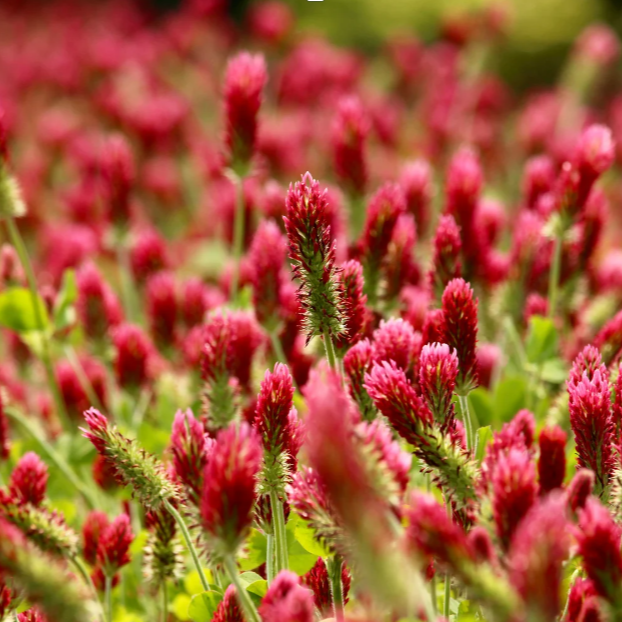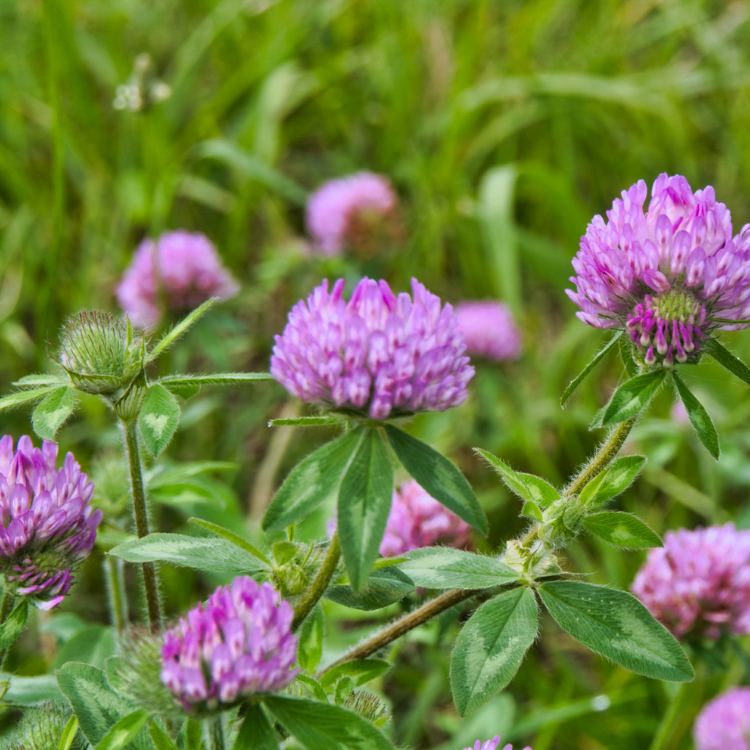Proprietary Legumes

CAPTAIN CRIMSON Clover
Captain Crimson is an annual clover renowned for its vigorous establishment, excellent biomass production, and superior nitrogen-fixing capabilities. This hardy, tap-rooted legume is particularly valuable as a companion crop for annual ryegrass, cereals, and other forage species, significantly enhancing pasture productivity. Its rapid early growth suppresses weeds effectively, while its early flowering provides substantial nitrogen fixation precisely when companion species need it most, boosting overall forage yield and quality.
Key Benefits and Advantages
Captain Crimson provides farmers with rapid, high-density growth, excellent winter and early spring performance, and consistent production under varying climatic conditions. It carries a notably low risk of livestock bloat, making it safer for grazing systems compared to other clovers. Due to its high nitrogen-fixing capacity, Captain Crimson significantly reduces reliance on synthetic fertilisers, improving pasture economics and sustainability. Its high biomass production delivers nutritious feed for livestock, resulting in improved animal growth rates and overall performance.
Soil and Climate Suitability
Captain Crimson thrives in moderately fertile, well-drained soils and adapts well to a wide range of climatic conditions, performing reliably even under moderate moisture stress. It achieves optimal productivity in regions receiving at least 450 mm annual rainfall or with supplemental irrigation, effectively tolerating short periods of drought once established.
Recommended Sowing and Management
Recommended sowing rates for Captain Crimson are 1–4 kg/ha when included in pasture mixes or 8–10 kg/ha for standalone crops, ideally sown no deeper than 10 mm to ensure rapid establishment. Optimal pasture management involves rotational grazing, allowing sufficient recovery periods to maximise biomass production and nitrogen fixation benefits. It responds well to minimal fertiliser inputs, especially phosphorus, to enhance growth and nitrogen fixation capacity.
Compatibility with Other Species
Captain Crimson blends exceptionally well with annual ryegrasses, cereals, and brassicas, significantly enhancing overall pasture productivity, forage quality, and livestock performance.
Other Legumes
-
White Clover
White Clover is a persistent perennial legume widely used in grazing systems for its forage quality, nitrogen fixation, and compatibility with grasses. Adaptable to various soil types, it thrives particularly well in fertile, moist soils, significantly enhancing pasture productivity and livestock performance through excellent nutritional content.
-
Arrowleaf Clover
Arrowleaf Clover is an annual legume that produces high-quality spring and summer forage, particularly suited to lower rainfall regions. It establishes quickly, offering excellent yields (up to 9,000 kg DM/ha), and is ideal for grazing or silage. Best suited to free-draining soils, it enhances forage availability during critical seasonal feed gaps.
-
Balansa Clover
Balansa Clover is an annual, self-regenerating legume highly adaptable to waterlogged or saline conditions. Ideal for challenging soils, it provides nutritious feed, excellent nitrogen fixation, and improves soil fertility. Its tolerance of wet conditions makes it particularly suited to winter-active grazing systems in marginal areas.
-
Persian Clover
Persian Clover is an annual legume valued for its palatable, high-quality forage and excellent regrowth capabilities. Best adapted to heavy or waterlogged soils receiving at least 450 mm rainfall annually, Persian Clover effectively bridges seasonal feed gaps, particularly during autumn, winter, and spring, enhancing livestock productivity.
-
Sub Clover
Sub Clover is an annual, self-regenerating legume widely used in grazing systems for its drought tolerance, forage quality, and nitrogen-fixing capacity. It performs best on acidic, well-drained soils in regions with winter rainfall patterns, significantly boosting pasture productivity and animal performance through consistent and nutritious forage supply.
-
Lucerne
Lucerne (Alfalfa) is a perennial, deep-rooted legume providing high-quality forage and exceptional drought tolerance. It excels in fertile, free-draining soils, offering consistent, high-protein feed, ideal for grazing, hay, and silage. Lucerne’s deep-rooting system enables reliable production, even under prolonged dry conditions, improving overall pasture resilience and livestock productivity.
-
Vetch
Vetch is an annual legume offering rapid establishment, excellent biomass production, and significant nitrogen fixation. Suitable for a variety of soils, it provides high-quality grazing, green manure, or hay, improving soil fertility and reducing fertiliser needs. Vetch integrates effectively into mixed cropping or pasture systems.
-
Lotus Corniculatus
Lotus Corniculatus is a perennial legume known for its tolerance of poor fertility and acidic soils. With good drought and grazing tolerance, it produces nutritious, tannin-rich forage beneficial for livestock health, notably reducing bloat risk. Particularly suited for challenging pasture conditions.
-
Strawberry Clover
Strawberry Clover is a highly adaptable, perennial legume tolerant of waterlogging, salinity, and alkalinity. With its deep-rooted, prostrate growth habit, it provides persistent ground cover and nutritious forage, particularly in difficult soil conditions. Excellent for erosion control, saline or waterlogged sites.
-
Forage Pea
Forage Pea is an annual legume valued for its rapid establishment, high biomass production, and protein-rich forage. Suitable for grazing, silage, or green manure, it effectively improves soil fertility through nitrogen fixation and integrates easily into diverse cropping or grazing systems.
-
Lupin
Lupin is an annual legume providing high-protein forage or grain feed, especially valuable in lower fertility or acidic soils. Known for vigorous growth and excellent nitrogen-fixing ability, Lupin improves soil quality and forage productivity, effectively supplementing pasture or cropping rotations.
-
Faba Beans
Faba Beans are an annual legume crop, producing high yields of nutritious forage or grain. Known for effective nitrogen fixation and adaptability to heavier soils, they enhance soil fertility and provide valuable livestock feed, supporting pasture productivity and sustainable cropping systems.

Red Rascal Red Clover
Red Rascal is a broadleaf perennial red clover known for its high forage quality, robust summer growth, and persistence in grazing and silage systems. With an upright, leafy growth habit, Red Rascal offers excellent palatability and nutritional content, especially valuable for grazing livestock or hay and silage production. Its deep-rooted structure enhances drought resilience, allowing it to produce forage reliably during drier summer months.
Key Benefits and Advantages
Red Rascal’s significant forage yields and high nutritional value provide consistent and reliable feed throughout summer and early autumn. Its excellent forage quality supports improved animal growth rates, increased milk production, and overall livestock performance. The deep-rooted system of Red Rascal ensures ongoing productivity during periods of moisture stress, enhancing pasture resilience and reducing reliance on supplementary feeding. Typically, Red Rascal persists beyond three years under good management, providing medium-term pasture stability and productivity.
Soil and Climate Suitability
Red Rascal performs best in fertile, well-drained soils but tolerates moderately acidic soils and short-term dry conditions effectively. Ideal rainfall conditions range between 600–1000 mm annually, though the deep roots enable productivity even in moderately drier areas, provided occasional irrigation or deeper soil moisture is available.
Recommended Sowing and Management
Red Rascal should be sown at rates of approximately 4–6 kg/ha when included in pasture mixes or 8–12 kg/ha for pure stands, with an ideal sowing depth of around 5–10 mm. Grazing management includes rotational grazing with pasture residuals kept above 5–7 cm, supporting consistent regrowth and long-term persistence. Fertiliser applications, particularly phosphorus and potassium, further support robust growth and forage productivity.
Compatibility with Other Species
Red Rascal integrates smoothly into pasture mixes alongside chicory, plantain, ryegrasses, and other legumes, providing diverse, resilient, and productive grazing pastures.
